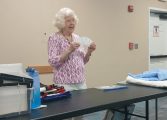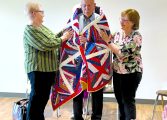“Begin by figuring out which brush strokes will accomplish creating the shapes,” he said. Breaking down several photographs, he discussed the angles, reflections, and shadows. “Spend time looking at the shadows, the contrast and details. Slow down, read what you see and translate it.”
He pointed out that foreground, middle ground and background are critical in landscape painting otherwise it falls flat and has no depth. Members soon discovered that there is science to seeing the relationship between shapes and distance.
Weidenheimer is a true believer in learning to paint realistically so that an artist can strengthen their eye and hand skills, seeing and rendering what actually exists in reality. To achieve this, he explained that looking at the construction of water and breaking it down into basic forms helps to paint it.
“The body or actual color of water, without reflections, is determined by water chemistry. Color may range from colorless or clear to green or amber or brown due to mineral staining algae.” Reflections also affect color value and knowing that light reflected from dark objects into water are lighter and lighter objects in water appear darker. He had many other tips regarding lights and darks and reflections that amateur artists tend to overlook because they think they know what it should look like rather than what really is present in the natural world.
To capture the variety of values associated with landscape color, he suggested only using 1-5 on the value scale instead of the usual 1-10 and pre-mixing the pigments, particularly if using acrylics.
The ripples in the water seemed daunting to some.
“Look at the shapes, ovals, no sharp edges, they blend smoothly,” he said. “Water has fewer lights and darks, it compresses the color values of the overall picture.”
He also cautioned the members that when painting a reflection of an object in water, paint the underside of the object or the mirror image of the object not a carbon copy of what already is seen.
“There are only a few natural settings in which the Bob Ross method of simply dragging shoreline colors downward across a lake will actually resemble what you see in nature.” He also added, “On real ponds and streams, and generally in shallow water you are able to see through the surface to the gravel and rocks below, as well as seeing a variety of patterns and ripples on the surface, plus mixed reflections of sky and objects on shore.” The goal of the workshop was to work on techniques for painting the actual appearance of ponds and streams.
The members went away with a new appreciation of water in the natural world.




